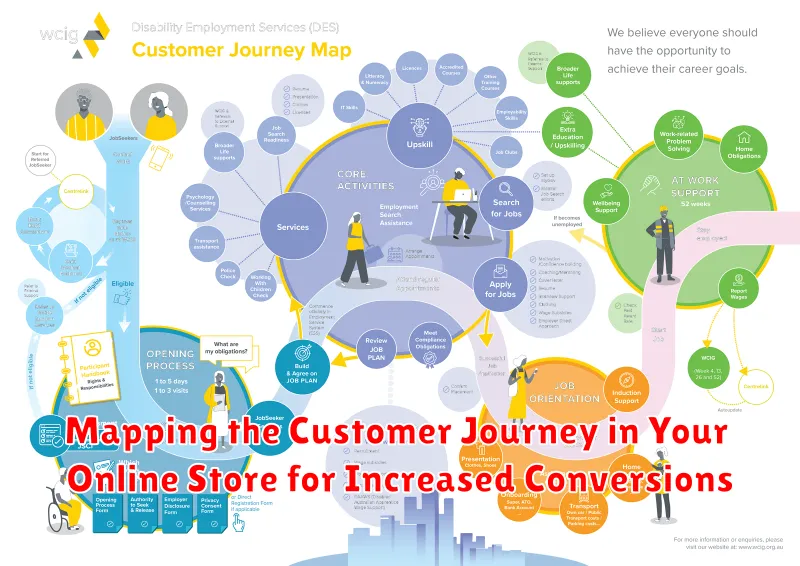Understanding the customer journey is crucial for any online store seeking to increase conversions. Mapping this journey allows you to identify key touchpoints and optimize each stage to create a seamless and persuasive experience for your customers. From the initial awareness stage, through consideration and decision, to post-purchase engagement, a well-defined customer journey map provides valuable insights into customer behavior and motivations. This allows you to tailor your marketing strategies, improve your website’s user experience, and ultimately drive more conversions and sales.
This article will provide a comprehensive guide on how to effectively map the customer journey within your online store. We will explore the key stages of the customer journey, discuss methods for gathering data and creating your map, and offer practical tips for optimizing each touchpoint for increased conversions. By the end of this article, you will have the knowledge and tools to effectively analyze your customer journey and create a more engaging and profitable experience for your online shoppers, ultimately leading to significant improvements in your conversion rate.
Understanding the Stages of the Customer Journey
The customer journey represents the various stages a customer goes through when interacting with your online store. Understanding these stages is crucial for optimizing the customer experience and ultimately driving conversions. Generally, the customer journey can be broken down into a few key phases.
Awareness
This is the initial stage where a potential customer becomes aware of a need or problem they want to solve. They may begin researching solutions, and this is where your store needs to be visible.
Consideration
Once aware of potential solutions, the customer starts evaluating different options, including your products or services. They compare features, prices, and reviews. Providing compelling information at this stage is key.
Decision/Purchase
At this stage, the customer has chosen a solution and is ready to make a purchase. A seamless checkout process and clear payment options are essential here.
Retention/Advocacy
After purchase, the journey continues. Nurturing the customer relationship through post-purchase engagement can foster loyalty and turn satisfied customers into brand advocates.
Touchpoints in the Online Customer Journey
Touchpoints are any interaction a customer has with your brand during their buying journey. Understanding and optimizing these interactions is crucial for driving conversions.
Key online touchpoints often include:
- Search Engines: A customer’s first interaction might be discovering your store through a search engine result.
- Social Media: Platforms like Instagram, Facebook, and Pinterest can serve as discovery and engagement touchpoints.
- Website: Your website itself, including landing pages, product pages, and blog content, represents a significant touchpoint.
- Email Marketing: Email campaigns can nurture leads and encourage repeat purchases.
- Online Advertising: Targeted ads on platforms like Google Ads and social media can re-engage potential customers.
- Customer Service Interactions: Live chat, email support, and FAQs are all valuable touchpoints.
- Reviews and Testimonials: Reading positive reviews can influence a customer’s decision to purchase.
By carefully managing these touchpoints, you can create a seamless and positive experience that guides customers towards conversion.
Mapping the Customer Journey: A Step-by-Step Guide
Creating a customer journey map provides a visual representation of your customer’s interactions with your online store. Follow these steps to develop an effective map:
1. Define Your Customer Persona
Identify your ideal customer. Consider demographics, psychographics, pain points, and motivations. A well-defined persona provides focus for your mapping efforts.
2. Outline the Journey Stages
Break down the customer journey into key stages, such as awareness, consideration, decision, and post-purchase. These stages represent the customer’s progress through the buying process.
3. Identify Touchpoints
Pinpoint every interaction a customer has with your store. This includes website visits, social media engagements, email interactions, and customer service contacts. List these touchpoints for each stage.
4. Analyze Customer Actions and Emotions
For each touchpoint, determine the customer’s actions and their corresponding emotional state. Are they confused, excited, or frustrated? Understanding their experience informs optimization efforts.
5. Visualize the Journey
Create a visual representation of the journey. This can be a flowchart, table, or other visual aid that clearly shows the stages, touchpoints, actions, and emotions.
Analyzing Customer Behavior at Each Stage
Analyzing customer behavior at each touchpoint provides valuable insights for optimization. This involves examining how customers interact with your online store during each phase of their journey. By understanding their actions, motivations, and pain points, you can tailor your strategies to effectively guide them toward conversion.
Key metrics to track include:
- Awareness Stage: Website traffic, reach of marketing campaigns, brand mentions.
- Consideration Stage: Product page views, time spent on product pages, add-to-cart rate.
- Decision Stage: Conversion rate, average order value, cart abandonment rate.
- Action Stage: Order completion rate, customer reviews, repeat purchase rate.
- Advocacy Stage: Social media shares, referrals, customer feedback.
Utilize analytics tools to gather data on these metrics. Identify patterns and trends to understand what’s working and what needs improvement. This data-driven approach allows for targeted optimizations and personalized experiences at each stage.
Optimizing the Customer Journey for Conversions
Optimizing the customer journey is an iterative process focused on removing friction and enhancing the user experience at each touchpoint. This involves analyzing data gathered from customer behavior and using it to refine your strategies.
Personalization is key. Tailor content, offers, and recommendations based on individual customer preferences and past interactions. This could include personalized email campaigns, product suggestions, or targeted advertising.
Streamline the checkout process. Minimize the number of steps required to complete a purchase. Offer guest checkout options, and ensure various payment methods are available. A clear and concise checkout process greatly reduces cart abandonment.
A/B testing different elements of your online store, such as call-to-action buttons, page layouts, and product descriptions, can reveal what resonates best with your audience and leads to higher conversion rates. Continuously analyze results and adjust accordingly.
Using Data to Improve the Customer Experience
Leveraging data is crucial for understanding and enhancing the customer journey. By analyzing website analytics, you gain valuable insights into customer behavior, preferences, and pain points. This data-driven approach empowers you to make informed decisions to optimize the customer experience and ultimately boost conversions.
Website analytics platforms provide a wealth of information, including traffic sources, bounce rates, time spent on pages, and conversion rates. By examining these metrics, you can identify areas for improvement within your online store.
For example, a high bounce rate on a specific product page might suggest issues with page loading speed, confusing navigation, or unclear product descriptions. Analyzing the data allows you to pinpoint these problems and implement targeted solutions.
Furthermore, tracking customer purchase history enables personalized recommendations and targeted marketing campaigns. By understanding individual customer preferences, you can tailor the shopping experience to their specific needs and increase the likelihood of repeat purchases.
Common Pain Points in the Online Customer Journey

Customers often encounter various obstacles while navigating an online store. Identifying these pain points is crucial for optimization and improving conversion rates. Some frequent issues include complicated navigation, making it difficult for customers to find desired products.
Slow website loading speeds can lead to frustration and abandonment. A lack of clear product information, including detailed descriptions and high-quality images, can create uncertainty and discourage purchases. Complex checkout processes with too many steps or unclear instructions are another major deterrent.
Limited payment options can exclude potential customers. Poor customer service, such as unhelpful FAQs or slow response times, can damage trust and loyalty. Finally, a lack of mobile responsiveness can alienate a significant portion of online shoppers.
Creating a Seamless and Personalized Experience

A seamless and personalized experience is crucial for converting browsers into buyers. By streamlining the purchasing process and tailoring content to individual customer needs, online stores can significantly boost conversion rates. This involves minimizing friction points and anticipating customer desires.
Personalization can take many forms, such as product recommendations based on browsing history, targeted promotions, and customized email campaigns. Addressing customers by name and offering personalized content creates a stronger connection and fosters loyalty.
Streamlining the checkout process is another key element. Minimizing the number of steps required to complete a purchase, offering various payment options, and providing clear shipping information can significantly reduce cart abandonment rates.
Providing excellent customer support also contributes to a seamless experience. Live chat options, readily available FAQs, and prompt responses to inquiries can build trust and encourage customers to complete their purchase.

